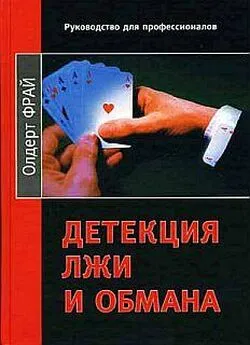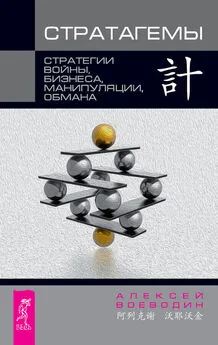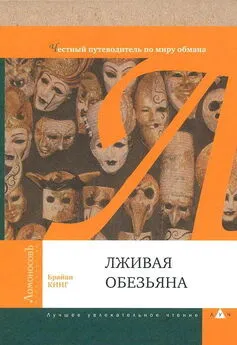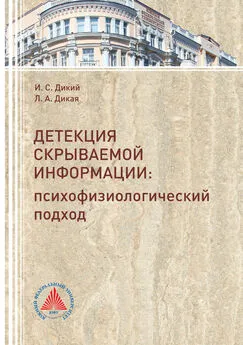Олдерт Фрай - Детекция лжи и обмана
- Название:Детекция лжи и обмана
- Автор:
- Жанр:
- Издательство:Издательский дом Нева ПРАЙМ-ЕРОЗНАК - Санкт-Петербург; ОЛМА-ПРЕСС - Москва
- Год:2005
- ISBN:5-93878-157-4
- Рейтинг:
- Избранное:Добавить в избранное
-
Отзывы:
-
Ваша оценка:
Олдерт Фрай - Детекция лжи и обмана краткое содержание
Как распознать ложь и обман в поведении и речи человека? Эти фундаментальные вопросы находят свое решение на страницах предлагаемого руководства. Без сомнения, эта книга — самый важный за последние годы вклад в теорию и практику психологии лжи и обмана. Впервые так полно и ясно представлены исследования психологических и физиологических показателей правдивого и лживого поведения и речи, а также — фактология использования метода детекции лжи и обмана с помощью полиграфа.
Эта книга принесет пользу всем, кто должен знать, говорят ли окружающие правду, и иметь практическое руководство, чтобы обеспечить себе это знание — для социальных и юридических психологов, криминалистов, политических консультантов и адвокатов.
Детекция лжи и обмана - читать онлайн бесплатно полную версию (весь текст целиком)
Интервал:
Закладка:
McCornack, S. A. & Levine, T. R. (1990). When lovers become leery: the relationship between suspicion and accuracy in detecting deception. Communication Monographs, 51,219–230.
McCornack, S. A. & Parks, M. R. (1986). Deception detection and relationship development: the other side of trust. In M. McLaughlin (Ed.), Communication Yearbook 9. Beverly Hills, CA: Sage, 311–389.
McCornack, S. A. & Parks, M. R. (1990). What women know that men don't: sex differences in determining truth behind deceptive messages. Journal of Social and Personal Relationships, 1, 101–118.
McCroskey, J. C. & Mehrley, S. (1969). The effects of disorganization and nonfluency on attitude change and source credibility. Speech Monographs, 36, 13–21.
Mann, S., Vrij, A. & Bull, R. (1998). Telling and detecting true lies. Paper presented at the Eighth Annual Meeting of the European Association on Psychology and Law in Cracow, Poland, September 1998.
Manstead, A. S. R., Wagner, H. L. & MacDonald, C.J. (1986). Deceptive and non-deceptive communications: sending experience, modality, and individual abilities. Journal of Nonverbal Behavior, 10, 141–161.
Manzanero, A. L. & Diges, M. (1996). Effects of preparation on internal and external memories. In G. Davies, S. Lloyd-Bostock, M.
McMurran & C. Wilson (Eds), Psychology, law, and criminal justice: international developments in research and practice. Berlin: Walter de Gruyter, 56–63.
Markham, R. (1991). Development of reality monitoring for performed and imagined actions. Perceptual and Motor Skills, 12,1341–1354.
Maxwell, G. M., Cook, M. W & Burr, R. (1985). The encoding and decoding of liking from behavioral cues in both auditory and visual channels. Journal of Nonverbal Behavior, 9,239–264.
Mehrabian, A. (1912). Nonverbal communication. Chicago, IL: Aldine-Atherton. Meitai Fan, R.,
Wagner, H. L. & Manstead, A. S. R. (1995). Anchoring, familiarity, and confidence in the detection of deception. Baste and Applied Social Psychology, 11,83–96.
Memon, A. (1998). Telling it all: the Cognitive Interview. In A. Memon, A. Vrij & R. Bull, Psychology and law: truthfulness, accuracy and credibility. Maidenhead: McGraw-Hill, 110–188.
Memon, A. &-Bull, R. (1999). Handbook of the psychology of interviewing. Chichester: John Wiley.
Merckelbach, H. L. G. J. (1990). Leugendetector kan gevaarlijk zijn. Intermediair, 26,35–31.
Metts, S. (1989). An exploratory investigation of deception in close relationships. Journal of Social and Personal Relationships, 6,159–119.
Millar, M. G. & Millar, K. (1995). Detection of deception in familiar and unfamiliar persons: the effects of information restriction. Journal of Nonverbal Behavior, 19, 69–84.
Millar, M. G. & Millar, K. (1991). Effects of situational variables on judgments about deception and detection accuracy. Basic and Applied Social Psychology, 19, 401410.
Miller, G. R., Bauchner, J. E., Hocking, J. E„Fontes, N. E., Kaminski, E. P. & Brandt, D. R. (1981)."…and nothing but the truth". In B. D. Sales (Ed.) , Perspectives in laze and psychology. Vol. II: The trial process. New York: Plenum, 145–119.
Miller, G. R., deTurck, M. A. & Kalbfleisch, P.J. (1983). Self-monitoring, rehearsal, and deceptive communication. Human Communication Research, 10, 91-111.
Miller, G. R., Mongeau, P. A. & Sleight, С. (1986). Fudging with friends and lying to lovers: deceptive communication in personal relationships. Journal of Social and Personal Relationships, 3, 495–512.
Milne, R. & Bull, R. (1999). Investigative interviewing: psychology and practice. Chichester: John Wiley.
Mitchell, R. W. (1986). A framework for discussing deception. In R. W. Mitchell & N. S. Mogdil (Eds), Deception: perspectives on human and nonhuman deceit. Albany: State University of New York Press, 3–4.
Moston, S. (1981). The suggestibility of children in interview studies. Child Language, 1,61–18.
Mulder, M. & Vrij, A. (1996). Explaining conversation rules to children: an intervention study to facilitate children's accurate responses. Child Abuse and Neglect, 20, 623–631.
Myers. B. & Arbuthnot, J. (1991). Polygraph testimony and juror judgments: a comparison of the guilty knowledge test and the control question test. Journal of Applied Social Psychology, 21, 1421–1431.
Neisser, U. (1981). John Dean's memory: a case study. Cognition, 9, 1-22.
Nigra, G. N„Buckley, M. A., Hill, D. E. & Nelson, J. (1989). When juries «hear» children testify: the effects of eyewitness age and speech style on juror's perceptions of testimony. In S.J. Ceci, D. E. Ross & M. P. Toglia (Eds), Perspectives on children's testimony. New York: Springer-Verlag, 51–10.
Ofshe, R. (1989). Coerced confessions: the logic of seemingly irrational action. Cultic Studies Journal, 6, 1-15.
O'Hair, H. D., Cody, M. & McLaughlin, M. L. (1981). Prepared lies, spontaneous lies, Machiavellianism and nonverbal communication. Human Communication Research, 1, 325–339.
Olsen, D. E., Harris, J. C, Capps, M. H. & Ansley N. (1991). Computerized polygraph scoring system. Journal of Forensic Sciences, 42, 61–10.
O'Sullivan, M., Ekman, P. & Friesen, W. V. (1988). The effect of comparisons on detecting deceit. Journal of Nonverbal Behavior, 12, 203–216.
O'Toole, D., Yuille, J. C, Patrick, C.J. & lacono, W G. (1994). Alcohol and the physiological detection of deception: arousal and memory influences. Psychophysiology, 31, 253–263.
Parham, I. A., Feldman, R. S., Oster, G. D. & Popoola, O. (1981). Intergenerational differences in nonverbal disclosure of deception. Journal of Social Psychology, 113,261–269.
Parker, J. F. (1995). Age differences in source monitoring of performed and imagined actions on immediate and delayed tests. Journal of Experimental Child Psychology, 60,84-101.
Patrick, C.J. & lacono, W. G. (1991). Validity of the control question polygraph test: the problem of sampling bias. Journal of Applied Psychology, 16, 229–238.
Peters, D. P. (1991). The influence of stress and arousal on the child witness. In J. Doris (Ed.), The suggestibility of children's recollections. Washington, DC: American Psychological Association, 60–16.
Podlesney, J. A. (1995). A lack of operable case facts restricts applicability of the Guilty Knowledge Deception Detection Method in FBI criminal investigations FBI Technical Report, Quantico, VA.
Poole, D. A. & White, L. T. (1991). Effects of question repetition and retention interval on the eyewitness testimony of children and adults. Developmental Psychology, 21,915–986.
Porter, S. & Yuille.J. C. (1996). The language of deceit: an investigation of the verbal clues to deception in the interrogation context. Law and Human Behavior, 20, 443–459.
Pynoos, R. S. & Eth, S. (1984). The child as witness to homicide. Journal of Social Issues,40, 81-108.
Pynoos, R. S. & Nader, K. (1988). Children who witness the sexual assault of their mothers. Journal of the American Academy of Child and Adolescent Psychiatry, 21,561–512.
Raskin, D. С. (1919). Orienting and defensive reflexes in the detection of deception. In H. D. Kimmel, E. H. Van Olst & J. F. Orlebeke (Eds) , The orienting reflex in humans. Hillsdale, NJ: Erlbaum, 581–605.
Raskin, D. С. (1982). The scientific basis of polygraph techniques and their uses in the judicial process. In A. Trankell (Ed.), Reconstructing the past. Stockholm: Norsted & Soners, 311–311.
Raskin, D. C. (1986). The polygraph in 1986: scientific, professional, and legal issues surrounding acceptance of polygraph evidence. Utah Law Review, 29, 29–14.
Raskin, D. С (1988). Does science support polygraph testing? In A. Gale (Ed.), The polygraph test: lies, truth and science. London: Sage, 96-110.
Raskin, D. C. (1989). Polygraph techniques for the detection of deception. In D. C. Raskin(Ed.), Psychologicalmethods in criminalinvestigation and evidence. New York: Springer-Verlag, 241–296.
Raskin, D. С & Esplin, P. W. (1991a). Assessment of children's statements of sexual abuse. In J. Doris (Ed.), The suggestibility of children's recollections. Washington, DC: American Psychological Association, 153–165.
Raskin, D. С & Esplin, P. W (1991b). Statement Validity Assessment: interview procedures and content analysis of children's statements of sexual abuse. Behavioral Assessment, 13, 265–291.
Raskin, D. C. & Hare, R. D. (1918). Psychopathy and detection of deception in a prison population. Psychophysiology, 15, 126–136.
Raskin, D. C, Kircher, J. C, Horowitz, S. W. & Honts, С R. (1989). Recent laboratory and field research on polygraph techniques. In J. С Yuille (Ed.) , Credibility assessment. Dordrecht: Kluwer Academic Publishers, 1-24.
Raye, С L. & Johnson, M. K. (1980). Reality monitoring vs. discrimination between external sources. Bulletin of the Psychonomic Society, 15, 405–408.
Reid, J. E. (1941). A revised questioning technique in lie detection tests. Journal of Criminal Law, Criminology, and Police Science, 31, 542–541.
Reid, J. E. & Inbau, F. E. (1911). Truth and deception: the polygraph (lie detector) technique. Baltimore, MD: Williams & Wilkins.
Reis, H. Т., Senchak, M. & Solomon, B. (1985). Sex differences in the intimacy of social interaction: further examination of potential explanations. Journal of Personality and Social Psychology, 48, 1204–1211.
Riggio, R. E. (1986). Assessment of basic social skills. Journal of Personality and Social Psychology, 51, 649–660.
Riggio, R. E. & Friedman, H. S. (1983). Individual differences and cues to deception. Journal of Personality and Social Psychology, 45, 899–915.
Riggio, R. E., Tucker, J. & Throckmorton, B. (1988). Social skills and deception ability. Personality and Social Psychology Bulletin, 13, 568–511.
Читать дальшеИнтервал:
Закладка:










